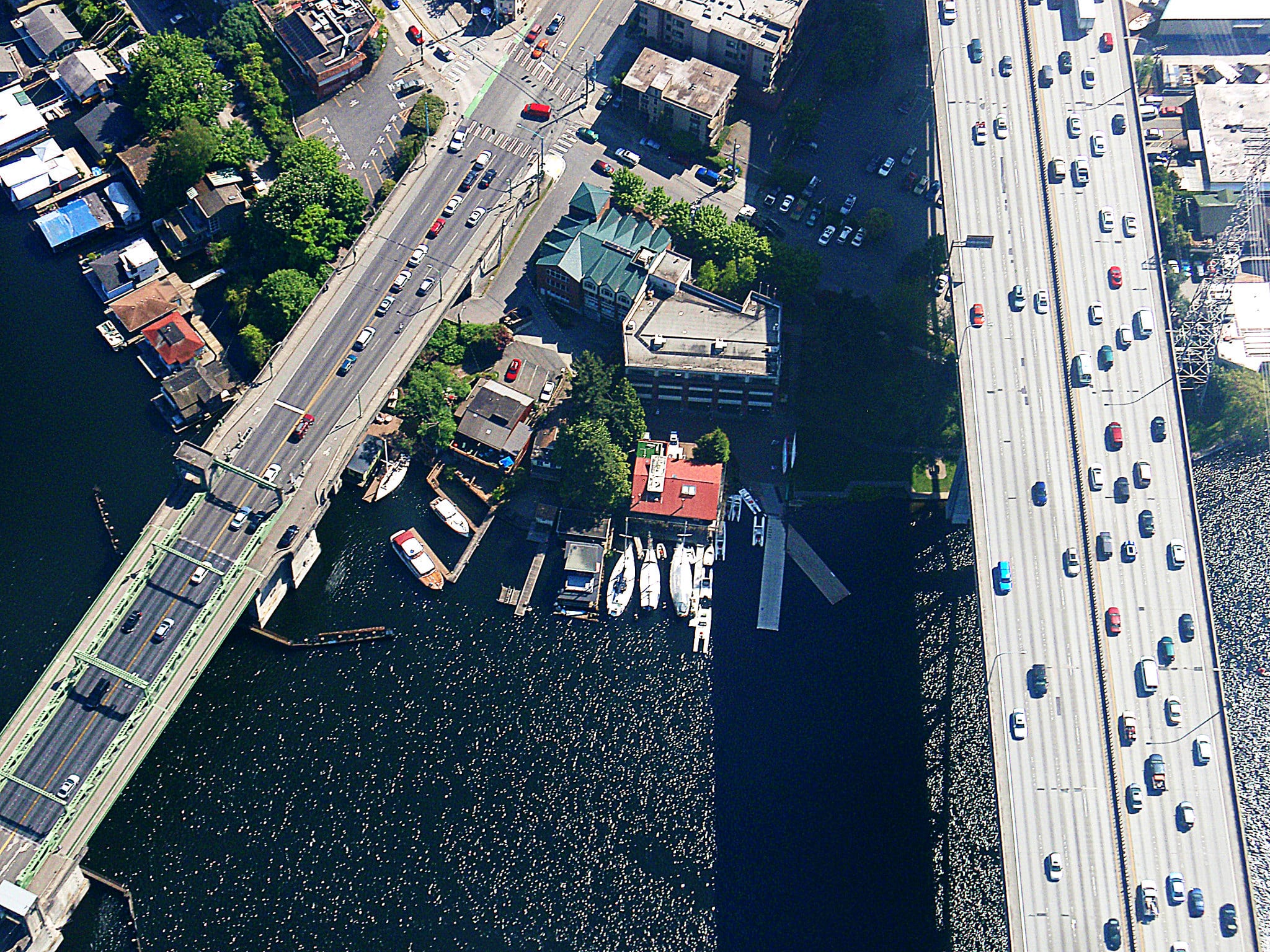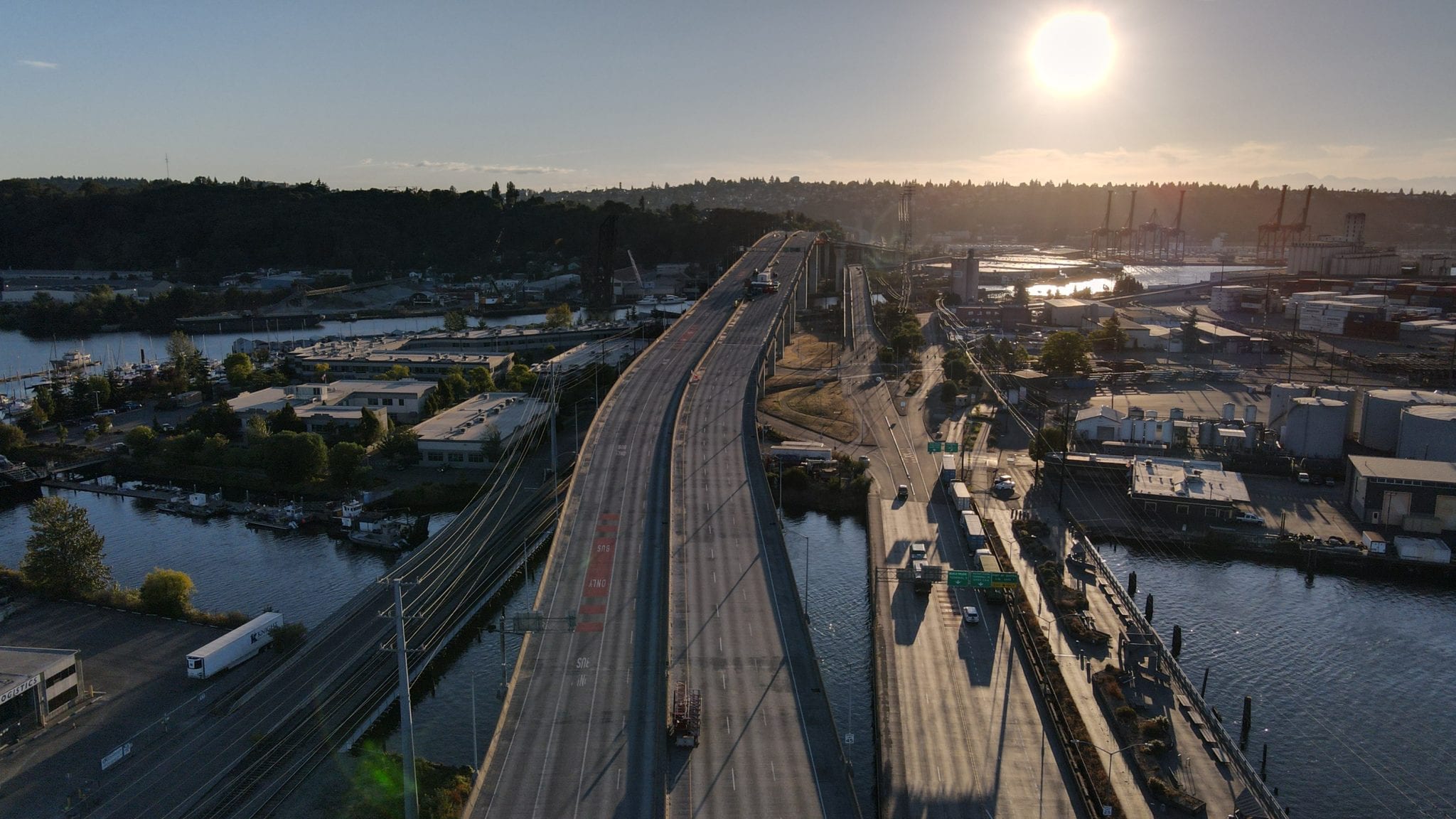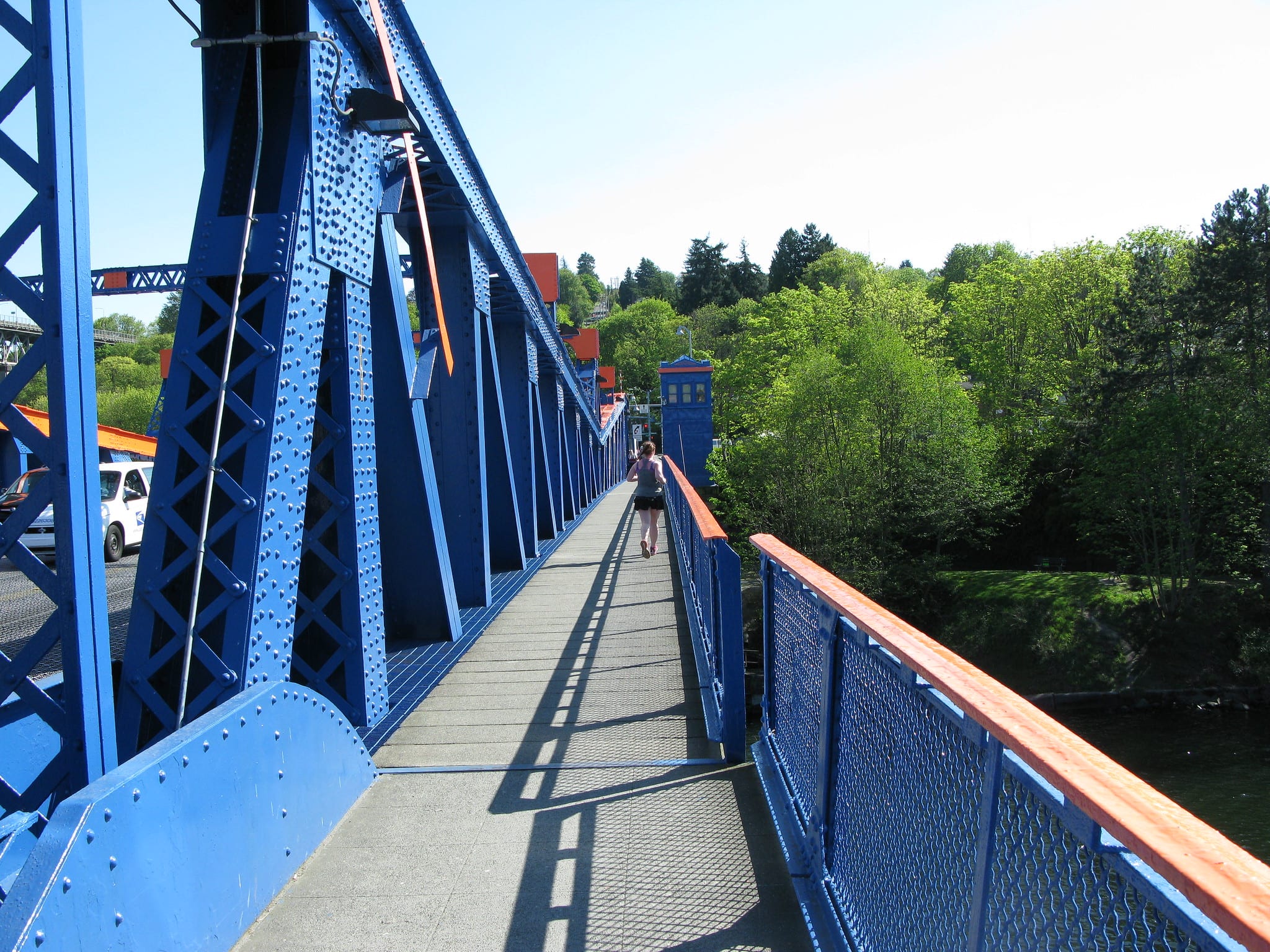 SDOT crews working on the West Seattle Bridge. Photo Credit: SDOT Flickr.
SDOT crews working on the West Seattle Bridge. Photo Credit: SDOT Flickr. Today, the Seattle Office of the City Auditor released an audit of our bridge maintenance program requested by Seattle City Council.
We appreciate the time they took to understand the complex engineering and financial aspects of our work, and our important role in supporting safety and mobility for the traveling public, preserving public infrastructure, and stewarding public funds. SDOT Director Sam Zimbabwe has written a letter in response.
DOCUMENTS RELEVANT TO THIS BLOG
SDOT Response Letter to City Auditor
April 23, 2020 – Councilmember Pedersen launches audit of Seattle Bridges
SDOT Response to Councilmember Pedersen
SDOT Capital Projects and Roadway Structures 2018 Annual Report (published in 2019)
We’re committed to developing a more comprehensive and proactive bridge asset preservation program that further maximizes the life of our critical infrastructure.
We’ve already begun this effort, but when it comes to maintaining public safety, we always strive to do better, and this audit serves to bolster those critical improvements already underway.

There are four key takeaways from this audit.
1. Public safety is our number one priority, so we always welcome expert opinions on how to further protect the traveling public when using, and taxpayer investments in, the City’s key infrastructure assets.
2. The issues that led to the closure of the West Seattle High-Rise Bridge on March 23 of this year do not appear to be the result of any deficiency in our bridge maintenance program. In fact and to the contrary, these critical issues were identified and quickly addressed as a result of our existing proactive, thorough bridge inspection program.
3. The most critical challenge we face is funding. The audit does highlight the need for additional funding for bridge maintenance, which is consistent with SDOT’s own reporting over the years, but it remains a challenge unresolved and the greatest obstacle to significant change.
4. We concur with 9 of the 10 recommendations, and partially concur with Recommendation 2, related to the percent of time our maintenance and inspections staff perform bridge work versus performing reimbursable work for other entities. Though SDOT already has a robust bridge maintenance program, the audit offers clear and helpful ways to strengthen these efforts and SDOT’s overall bridge maintenance program.
Here’s a breakdown of the key takeaways:
1. Safety is our number one commitment.
We’re always open to ways to do better when it comes to public safety, and welcome this collaborative process to improve on an already strong program.
Audits are one way of ensuring that government is accountable to the people and neutral expert opinions are brought to bear on existing practices as a means of improving existing processes. We appreciate this thorough review of our program and generally agree with most of the audit’s recommendations and findings, many of which validate our own program evaluations and reporting of recent years.

2. The issues that led to the closure of the West Seattle High-Rise Bridge on March 23 of this year do not appear to be the result of any deficiency in our bridge maintenance program.
In fact and to the contrary, these critical issues were identified and quickly addressed as a result of our existing proactive, thorough bridge inspection program, which is a function of bridge maintenance.
- The sudden growth of cracks in the West Seattle Bridge were identified and quickly addressed as a result of our existing proactive and thorough bridge inspection program. We inspected this bridge at least once every year from 2013 – 2020, which is twice as frequently as required by federal guidelines. In 2019, we began a robust structural analysis associated with the bridge’s weight load rating which is how we were able to promptly catch when several cracks grow by over a dozen feet in just over two weeks in March 2020.
- The existing processes and systems in place did what they are supposed to do – identify dangers to the public so timely, appropriate action can be taken. Our team of bridge engineers identified critical issues in the West Seattle High-Rise Bridge in time, took no chances when it came to public safety, and made the difficult call to recommend immediately closing the bridge.
3. The audit underscores the need for new maintenance funding, consistent with previous SDOT assessments.
Until we work across all levels of government to find scalable, sustainable solutions, however, this will continue to be a key challenge.
- We take the City Auditor’s recommendations to enhance our bridge maintenance program very seriously. One of the key challenges identified by the audit is that considerable additional funding for infrastructure maintenance will be required to implement many of their suggestions. For SDOT, this is the first and central challenge. The audit echoes what SDOT has transparently highlighted time and again when it comes to additional funding needs, most recently in our 2019 Capital Projects and Roadway Structures Annual Report.
- While the audit does not address where this funding would come from, it makes it clear that we need to focus on finding sustainable funding first. This is the most important step to ensure further improvement of our bridge inspection program and overall health of our structures.
- This challenge is not unique to Seattle. Like every major city in the United States, Seattle is stepping up to the challenge of maintaining our aging infrastructure in the face of grossly insufficient funding support from the federal government.
- Federal infrastructure investment in relation to gross domestic product (GDP) has fallen by half over the last 35 years (slipping from 1% to 0.5% of the GDP).
- Despite inflation, the federal gas tax rate, a primary source of transportation funding, has not changed since 1993, resulting in a 60% loss of purchasing power while construction costs have kept going up.
- This leaves a disproportionate bulk of this burden to state and local governments to deal with a $123 billion backlog of unfunded bridge rehabilitation needs.
- However, Seattle also faces additional budget challenges. This is due to severely limited options on what kinds of taxes can be used to fund transportation investments, and by statewide ballot initiatives which threaten to counteract local transportation funding overwhelmingly supported by Seattle voters.
4. We concur with 9 of the 10 recommendations provided by the City Auditor, and partially concur with Recommendation 2.
At the end of this blog, and in Appendix B of the audit report, we outline each of these recommendations and what we’re doing to address them.

Despite funding challenges, we continue to prioritize the safety and resiliency of our transportation infrastructure while simultaneously making the new investments necessary to keep our city moving as our population grows at unprecedented rates.
- Our Roadway Structures group continues to operate as efficiently as possible to deploy resources and maintain public safety. Skilled crews perform maintenance work and larger capital projects on many of Roadway Structures-managed assets, alongside qualified engineers and engineering technicians who inspect and assess structural assets.
- While our bridges were the focus of the audit, we’re also making sure we maintain roadway surfaces, seawalls, non-vehicular bridges, areaways and other infrastructure. Each of these 238 areaways, 613 retaining walls, 502 stairways, or 124 bridges have unique maintenance and funding needs, and play critical roles in our transportation network. This responsibility is what drives the beginning, middle, and end of each day at SDOT.
- Seattle voters have repeatedly chosen to invest in transportation infrastructure and public safety. For example, the Move Seattle Levy is funding the replacement of the Fairview Ave N Bridge and the seismic reinforcement of other bridges. We also continue to expand our inventory with the Lander Overcrossing and Northgate Pedestrian and Bicycle Bridge currently under construction.
We’re looking forward to addressing these recommendations, increased awareness of our infrastructure challenges, sharing updates in the future, and continuing to maintain our bridges and other structures to ensure everyone in Seattle can get around safely!
| Recommendation | Why This Is Important | So, SDOT will: |
Recommendation 1: SDOT should take immediate steps to resolve all the issues identified in the 2019 Federal Highway Administration review. | We invited the Federal Highway Administration (FHWA) to conduct an informal review of our bridge program in late 2019. They shared their findings in July 2020, which include areas – like improving our documentation of bridge condition and inspection data – to address before we can pass the FHWA’s next formal review in 2022. | Create a more refined work order reporting & assessment. Create a new one-year temporary staff position to support strategic, long-term capital replacement and maintenance needs plan for bridges, and addressing bridge inspection issues found during the informal 2019 FHWA audit. |
Recommendation 2: SDOT should reduce the share of the department’s maintenance workload that is currently dedicated to reimbursable projects unrelated to SDOT bridge maintenance. Such a change could be done incrementally. | About 20% of SDOT’s bridge maintenance staff capacity is dedicated to performing reimbursable work for other divisions within SDOT, other City departments, or other local governments. This affects the type of projects that bridge maintenance crews do. | As funding levels are determined by City Budget Office and City Council, complete the staffing analysis mentioned elsewhere in this audit and to use it to determine the appropriate staffing and funding levels for the Roadway Structures Division as a whole. |
Recommendation 3: SDOT should develop draft legislation to replace Ordinance 96715 to address current City of Seattle bridge maintenance priorities and ensure adequate oversight of private bridges. Recommendation 4: SDOT should develop policies and procedures to adequately oversee private bridges that align with a revised version of Ordinance 96715, as mentioned in Recommendation 3. | A 1968 Seattle Municipal Ordinance requires SDOT to perform a safety inspection of privately owned bridges annually, and having SDOT inspect private bridges may delay work on public bridges. | Work with the SDOT Street Use Division and the City Attorney’s Office to draft a reworked ordinance for consideration by City Council. Roadway Structures will work with the SDOT Street Use Division and the City Attorney’s Office to draft a reworked ordinance for consideration by City Council. |
Recommendation 5: SDOT should conduct a staffing analysis to determine the number and type of staff required for the implementation of a bridge preservation program. Recommendation 6: SDOT should incorporate the City’s Race and Social Justice Initiative values into the staffing analysis of its bridge program. Recommendation 7: SDOT should conduct a cost benefit analysis of technology upgrades needed to improve staff efficiency as part of their staffing analysis. | SDOT crew assignments are not consistently aligned with bridge inspector expertise, meaning less experienced staff can be assigned to more complicated work. Inspection and maintenance crews have in-office administrative responsibilities that take them away from critical work on the assets themselves. Some of this work involves duplicative data entry and other inefficiencies, which reduces SDOT’s capacity to perform critical bridge maintenance work. | Use the federal guidelines recommended in the audit to conduct a staffing analysis based on element level condition data. Conduct a Racial Equity Tool Kit exercise to analyze proposed new methodologies for staffing analysis. Identify technologies needed to conduct inspection and work order execution more efficiently along with associated costs for new technology. |
Recommendation 8: SDOT should update the estimated useful life of their bridges using the condition data of individual bridge components. Recommendation 9: SDOT should use the updated useful life estimates of its bridges to plan for preservation work and lifecycle costs. | SDOT does not currently calculate the useful life of its bridges in a precise way, which hinders its ability to efficiently respond to bridge maintenance needs. Several unforeseen factors have changed since most of Seattle’s bridges were built, such as the size of vehicles, traffic volume, and environmental effects due to climate change, so agencies need to periodically update the expected useful life of each bridge. | Develop an implementation plan for this based on available staffing and funding levels. |
Recommendation 10: Once SDOT has accurate condition data, updated estimated useful life calculations, and lifecycle cost data, SDOT should develop a strategic asset management plan and the City should work to develop and implement strategies to fill the bridge maintenance funding gap. | The greatest improvement to be made for all Seattleites, and SDOT’s bridge maintenance program in particular, is increased funding. SDOT cannot achieve that on its own, nor can the City. But a unified ask and effort to pursues that ask will be critical and is a welcomed step forward. | Develop a strategic asset management plan for bridges and the City will work with state, Federal and other funding partners to develop and implement strategies to fund bridge maintenance more fully. |